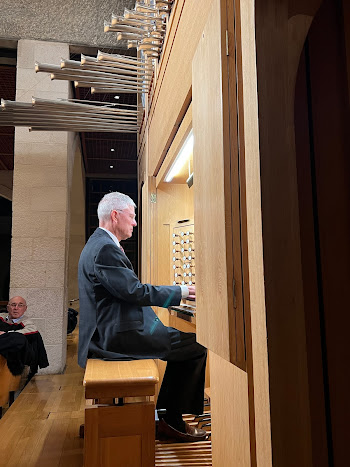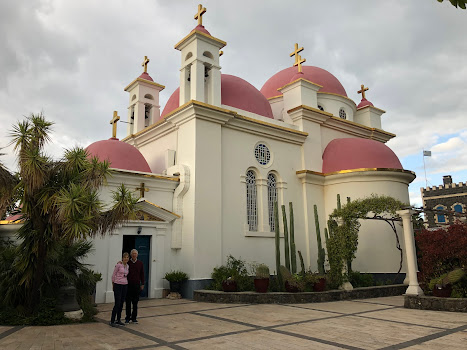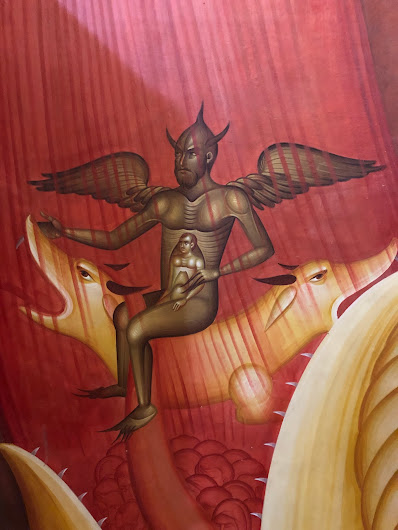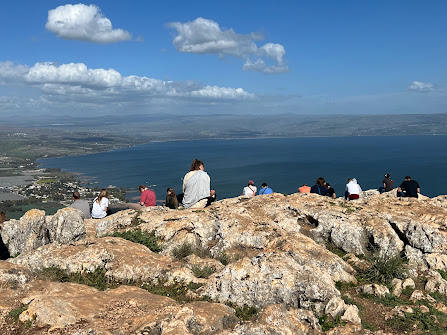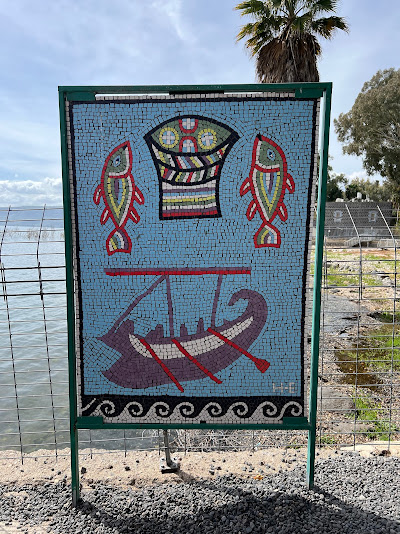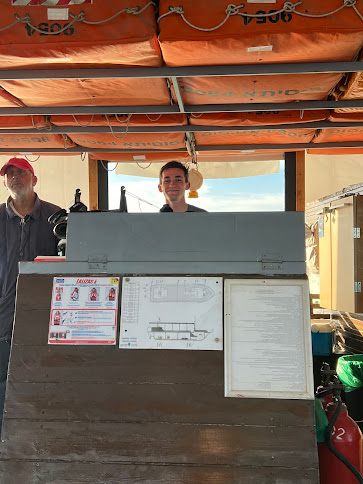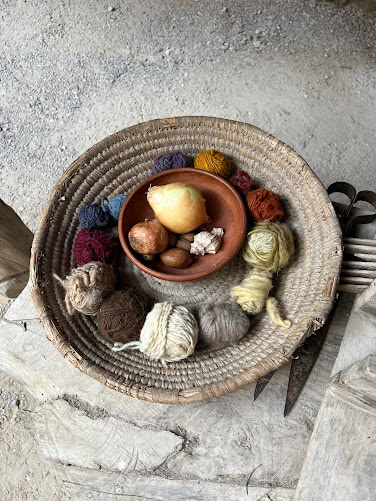ALERT--this was a busy, action-packed week!
We joined the Barkers and Rosens at the Knesset for a nice tour given by Moshe from Philadelphia (he's lived in Israel for 45 years now). We had been before but it was good to go again. The Speaker of the House was with a visiting group and greeted our little group.
March 6, Monday: Up early, left by bus at 7:00 am for the Galilee trip. First stop was Bet She’an, which we love. Eric Huntsman and David Seely lectured, so learned more of the history this time. Jim walked down to the area of an old bridge, saw columns and ruins among the mustard in bloom. Deanne went to the top of the tel for the overlook view. Beautiful view and day.
Then to Mt. Tabor, the traditional site of the transfiguration. An impressive hill in the middle of the Jezreel Valley. Many devout pilgrims there, especially a group from Nigeria. We saw one man kneeling and praying at a large stone. Beautiful views over the valley.
Then to Mt. Arbel, overlooking the Sea of Galilee. Such perfect weather, water, and skies.
Then to Yardenit, a traditional baptismal site where the Sea of Galilee drains into the Jordan River. Much more inviting than the murky baptismal site near Jericho! Many tiles in different languages repeated the scripture of the baptism of Jesus. The Hawaiian pidgin one was our favorite.
"You my boy!"
Checked in at Ein Gev resort. Had a tour of the banana plantation at the Ein Gev kibbutz and a tour of the kibbutz itself by Eric, a Jewish man from New Jersey who has lived here for 31+ years. He showed us the various buildings, synagogue, bomb shelters, schools, laundry, store, etc., and then had a Q&A session. Very interesting to be on a real kibbutz. Dinner at Ein Gev buffet, good Israeli food!

Jo Ann and David Seely enjoying the afternoon
March 7, Tuesday: You know how you feel when you go to a really wonderful church service? You don’t want it to end. That’s the way our tour was today when we visited some of the most important Biblical sites on the northern end of the Sea of Galilee. First, a walk up Wadi Hammam, or Valley of the Doves, which was the route Jesus walked from Nazareth to Galilee. Walking this rocky path in the peace and solitude of the morning was a spiritual high.
Magdala is always a treat, right on the shore of the lake. Maybe Jesus taught there? We saw the excavated synagogue, the wonderful painting of the woman touching the hem of the Savior’s garment, and our students sang in the rotunda of the church. The other visitors there were impressed and moved.
The podium in the church is situated in the boat
We had short visits to two more churches: St. Peter Primacy, right on the edge of the water, where the risen Lord appeared to seven of his disciples who were fishing in the Sea of Galilee; and the Multiplication of the Loaves and Fishes, which commemorates the miracle of Jesus’s feeding 5000 from a few loaves and fishes.
Then up the hill to Chorazin, where Jesus rebuked the inhabitants for their failure to repent. The structures were all made of basalt there—dark volcanic rock.
And a visit to the Mount of Beatitudes, with a devotional and discussion of those eight important verses. That mountainside now has acres of banana farms—probably not the case 2000 years ago. We had a longer visit at Capernaum, “the Town of Jesus,” with a devotional by Eric Huntsman and time to wander, explore the town, and reflect privately on Jesus’s ministry right here. Capernaum was the site of more recorded miracles than any other site and was also the scene of many of Jesus’s teachings and activities.
Mosaic on the face of the altar
New to us was the visit to the recently excavated 2000-year old fishing boat at Ginosar. About 10 meters long, but you could imagine Peter and others fishing in a boat like this, and Jesus teaching from the boat to the throngs on shore.
We ended the day with a delightful boat ride all the way across the Sea of Galilee back to our “home” at Ein Gev on the eastern shore. What an experience—spending all day in the actual footsteps of Jesus.
So many hungry birds!
Boys in the boat
Jacob Griffin at the helm
March 8, Wednesday: Didn’t have to get up early! We enjoyed a leisurely breakfast, and then a walk up to the Ein Gev kibbutz, past their banana plantation, along the shore and dock, through a forest of palm trees.
Frank Judd invited us to go up to Hippos, a national park set to open soon, one of the Decapolis cities on the hill just above Ein Gev. Extensive ruins of buildings, theaters, churches, etc., but also Syrian bunkers from the 1967 war—in our lifetime! Frank Judd
After lunch, Jim went in search of Meshushim Nature Reserve with the hexagonal pool that his sister Barb told him about. Deanne had hoped to sit by the beach at Ein Gev, but a big wind came up, dark clouds, and so it was a bust. So different from yesterday. Didn't stop the students from swimming though...
We had dinner at the fish restaurant at Ein Gev kibbutz. A real tradition with “St. Peter’s fish,” a whole fried fish. The sides, pita, and fries were tasty, and everyone got into the act kissing their fish. A few students ate the fish eyeballs. Alka-Seltzer later in the night.
March 9, Thursday: Such a great field trip today to the Jezreel Valley with the students. The fields were brilliant green with tons of yellow mustard plants. Israel doesn't always look so fertile and colorful. First stop was the Spring of Harod, where Gideon had to reduce his army of 32,000 to 300 but still defeated the Midianites.
On our drive we encountered people protesting potential changes to the power of the Israeli supreme court by driving tractors and other slow vehicles, intentionally blocking traffic. Slowed us down a bit, but interesting to see modern history in action.
Tel Megiddo is a World Heritage site and the place of many crucial battles over the millennia. This is also Armageddon (which means Mount Megiddo). There are those who say the final battle of good versus evil will take place here, but that’s unlikely since there’s nothing to defend now at the site. Not surprisingly, Tel Megiddo offers amazing stonework, water systems, mangers, stables, temples, and sacrificial altars.
Ben Cochran, Seth Clawson, Brandon Checketts, Jacob Griffin
Then on to Nazareth. We first went to Nazareth Village, where they recreate a village similar to that which Jesus might have lived in. We had an excellent guided tour of the olive orchards, sheep pen, tomb with rolling stone, vegetable garden, potter, weaver, and a replica of a 1st century synagogue. The guide described each station with very appropriate scriptures about Jesus. Yes, it was slightly like a theme park, but it was very inspiring at the same time. We also had lunch there—lentil soup, fresh lafa bread, hummus, spices, olives, cabbage salad, roasted chicken, and apple slices with date honey for dessert. (They requested we not post pictures of the workers.)
Bus driver, Amjab
Last to the famed churches of Nazareth. First, the Synagogue Church, where Jesus read from Isaiah 61:1-2, making the first public announcement of his messiahship (and was rejected by those in attendance).


Next to the Church of St. Joseph, and last to the Church of the Annunciation, which is the largest church in the Middle East. It was built in 1955 over a traditional site and includes many beautiful mosaics and paintings from around the world in tribute to Mary the mother of Jesus. Frank Judd invited Deanne to lead a devotional there with thoughts about Mary and motherhood and she did a fine job (even if other tour groups kept walking right in front of her as she was speaking…). The church also boasts the second largest organ in Israel (a very gutsy Rieger organ of 49 stops, second only to the organ at the Church of the Nativity in Bethlehem, with 52 stops). Jim had made arrangements with the organist there, George Lewette (originally from Fairfax, VA), who let him play for a few minutes between masses. He played “Jesus of Nazareth, Savior and King,” “All Creatures of Our God and King,” and “Come, Come, Ye Saints,” which the students enjoyed hearing in this magnificent church. We were all on a high by the end of this day, and returned through flowering fields to the Sea of Galilee and dinner at Ein Gev.




Grotto of the traditional site of the Annunciation to Mary
March 10, Friday: While the students were in class, Jim drove again to Meshushim Stream in Yahudiya Nature Reserve in the Golan area, about 15 miles north of Ein Gev. The trail goes down into a gorge, through some nice wildflowers and volcanic rock. Views of the snow-covered Mt. Hermon are off in the distance. The pool is impressive, with the hanging lava columns. After lunch we went up to Hippos so Deanne could see the extensive ruins of buildings, theaters, churches, etc. We enjoyed a little time with the students on the “beach.” It was a perfect weather.
Anemones (similar to poppies)
March 11, Saturday: We joined the students on the bus to Tiberias for church. The Tiberias building is a “villa,” probably from the 1970’s. They’ve made it into a chapel upstairs, and classrooms downstairs. Fantastic view over the Sea of Galilee. Shorty Deanne with Ben Cochran and Seth Clawson (who is 6'5")
And then back to Ein Gev to turn the apartment keys over to the Barkers who replaced us for the second week of the Galilee experience. More protests on the way home but nothing to worry about.


